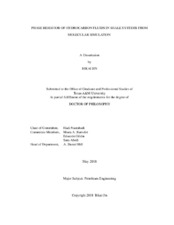| dc.description.abstract | Production from shale reservoirs is getting more attention from the oil industry.
However, the shale is not understood as well as conventional reservoirs. One complexity
is the unclear fluid phase behavior in shale nanopores. Since the knowledge of the
hydrocarbon phase behavior is fundamental for the petroleum reservoir simulation, the
phase behavior in shale reservoirs has received significant attention in recent years. Since
hydrocarbon fluids are stored inside nanopores of shale matrices, a great interaction exists
among the pore boundary and fluid molecules. Thus, fluid phase behavior in a shale
reservoir is substantially different from conventional behavior. Due to this interaction,
the fluid molecules are distributed heterogeneously inside the nanopores and the phase
diagrams are shifted under confinement.
Molecular simulation techniques have been developed in previous studies for an
advanced performance in the phase behavior description under confinement. In this
work, a new molecular simulation method, gauge-GCMC, is presented to study the phase
behavior of multiple component fluids considering the confinement effect. This method
is verified by matching the phase diagrams of simple and complex hydrocarbons with
theoretical results and the simulation data from other techniques. The simulation results
show that the density differences between vapor and liquid phases are reduced while
critical densities increase under confinement. Also, the confined phase behavior has
a great change in the fluid compositions, because heavier components have a stronger
adsorption effect than that of lighter components.
Shale rocks usually have a wide pore size distribution (PSD) and the traditional single
pore-size models are not accurate enough to represent a real shale system. To understand
the PSD effect on the phase behavior, the gauge-GCMC is used to generate phase diagrams
based on two types of cylindrical models (single pore and multiple pores, including one
based on Eagle Ford shale rock). The simulation results show that with an increasing
pore size, the phase equilibrium properties approach the bulk values. In addition, the
small pore causes a stronger shift in the phase diagram, compared with large pores. The
small pores are filled before the large ones, which means that liquid condensation will
first happen in the small pores. In the Eagle Ford test, it is possible to use a single pore
model with a 10 nm diameter to represent the phase diagrams of this complex pore system.
To investigate the contribution from boundary material on the fluid phase behavior, two
types of pore models (slit and cylinder), which are built from three materials (two inorganic
minerals and one kerogen), are used to generate the phase diagrams of pure fluids (Cv1 and
Cv3) and one ternary fluid (Cv1/Cv3/nCv5). Under confinement, liquid densities are reduced
while vapor densities are increased in both pore models. Critical points are shifted to
lower densities. For the ternary case, a large shift of the nCv5 composition is shown in
the vapor phase ternary diagrams, while only small changes have been observed in the
liquid composition. When the temperature increases to one typical shale condition, phase
separation of the ternary fluid is available in slit pore tests, while only one phase is formed
in tests of cylinder pores. Based on the comparison of all results, the cylinder pore, which
has more adsorption surface area, can provide a stronger adsorption effect than the slit
pore. The calcite models have a greater confinement effect on fluid properties, and the
other two materials cause the similar shift effect on phase diagrams. | en |


